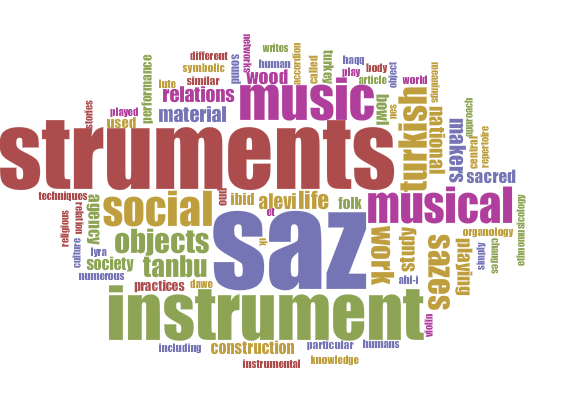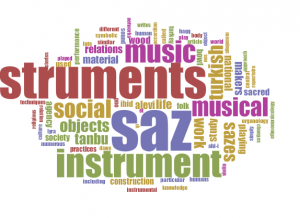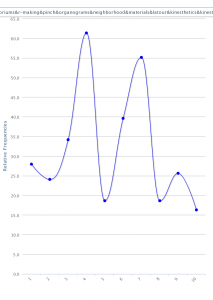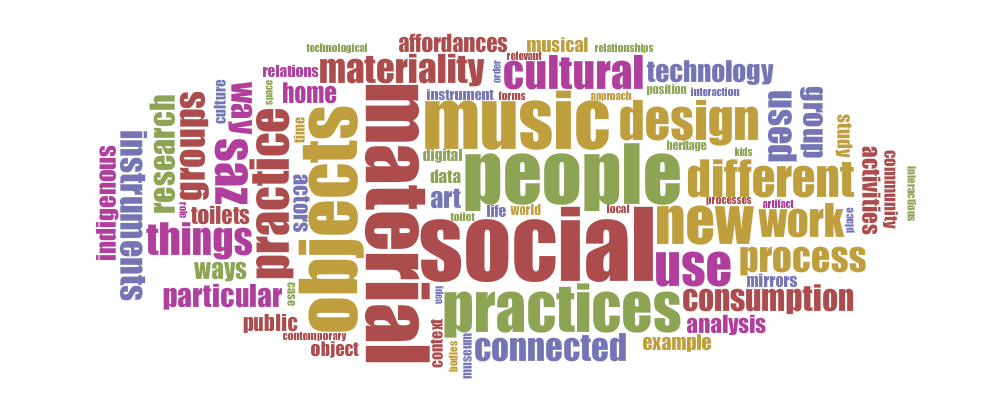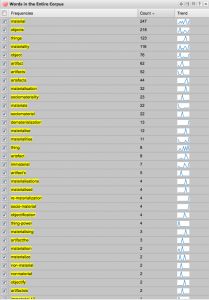Context is key
Been thinking about learning. Nothing new there. What’s somewhat new is context. Context is complex, which is part of the reason I love contextuality so much.
In this case, the immediate context is “the holidays”, and more specifically, a time when I feel free to explore some things about which I deeply care. Hence, learning.
The broader context is that I applied for a position, back in late September. I’m still confident that I should eventually get this position (as, in all honesty and humbleness/humility, I know I’m the ideal person for the job), but the process is quite long and, according to people involved, effortful. Which means I’m in a sort of liminal state.
The position is for an education specialist in charge of an online learning portal affiliated with museums and other heritage institutions. Part of the work has to do with managing online resources meant for use in (formal) learning contexts. This material comes from museums and heritage societies and consists of (heritage) objects, lessons, and collections. Those who know EdTech can understand these items as “learning objects”, with all associated benefits and disadvantages.
Rethinking Learning Material
So I went back to the Learning Object (LO) literature (PDF). A bit messy and dusty, but I find quite a bit of value, in there. While I understand objections education and EdTech specialists have had as to the LO concept itself, I’m interested in work which has been done under the LO banner. The concept has lost much of its currency in some specialist contexts, but a specialist may still find inspiration in work which surrounded it.
I first learnt about LOs during the Spirit of Inquiry conference, back in 2007. That conference opened a “whole new world”, for me. I participated because it was hosted by my (still-current) learning institution and I tend to participate in all sorts of learning- and teaching-related activities, whenever I can. My own presentation (slidecast) was directly connected to what I later came to know as LOs. My basic idea was that learning material which could be shared online had some important benefits. Namely, this material can be free (as in speech), open, and flexible.
What I had in mind was quite simple. And I perceive this simplicity as a strength. I was talking about the kind of material that we, teachers, create anyway, regardless of other uses. You know, things like syllabi, handouts, bibliographies, quiz questions, study guides, lecture notes… Stuff which is sometimes taken to be “the content” of our work, but tends to merely be support for our teaching efforts. Some of us already share these with students and colleagues, whether or not we wish to protect them as our “intellectual property” (quiz questions don’t qualify, apparently). Other people guard them fiercely, often claiming that these things are the bulk of their “work”. Though I understand and respect the sentiment, I strongly feel that this stance devalues the rest of what we do namely, y’know, teaching.
But I digress.
Getting into Learning Objects
I was presenting “learning objects” without calling them as such. I was talking about “learning material” as anything which can be used in (or created through) learning contexts. I was unaware of conversations on LOs which had been happening for years (PDF), in the specialized field of “those who talk about education”. And when I first heard about LOs, I had a sort of driftoff moment, which I often have with learning content.
It happened during that same conference. Pierre-Julien Guay and Vitrine technologie éducation did a presentation on LOs and Learning Objects Repositories (LORs) called: The Tools of Online Learning: Learning Objects and Repositories. I was taken by the Mouse Party one, finding it both fun and effective (though I’m not often taken by these whiz-bang proof-of-concept multimedia features). More importantly, I was dreaming about possibilities afforded LO creation tools. Guay claimed that some of these could be created quite effortlessly, or so I remember. Certainly, Mouse Party took a lot of time, planning, and effort to successfully come out as a finished product with high production value. But VTÉ was able to help teachers create diverse LOs which would have plenty of benefits.
As it turns out, I have recently reconnected with Guay and should collaborate with LaboVTÉ in the near future. My memory of that Spirit of Inquiry talk is likely embellishing the truth. But that’s what happens with inspiration moments. I was imagining new possibilities for material to be used by learners. It made me quite enthusiastic. And it’s been among my dreams ever since.
Managing Learning Material
Since that time, I shifted my roles around quite significantly. Though I still give courses at Concordia, I’ve also become a freelance researcher and took a turn toward more extensive roles as an education specialist/consultant. Part of it was thanks to Spirit of Inquiry which paired me with John Bentley, an EdTech specialist and former producer who works at Concordia’s Centre for Teaching and Learning Services (CTLS). John, who became a good friend in the intervening years, was the one who made the introduction to my SoI session. Before we got started, he demonstrated some interest in my work and, after the session, enjoined me to do things with CTLS. Since that time, John and I have been doing workshops and other activities with CTLS, mostly focused on education uses of social media and other so-called “Web 2.0” services and tools. John also did a screencast (currently offline, it seems) with me on the same topic, and we’ve done a type of community management work, trying to help members of the Concordia community appropriate social media.
I haven’t really been creating or managing LOs at Concordia, but I did extensive work on online learning portals. Last summer, for instance, I created mockups of my ideal “learning management system” for the fun of it. These mockups were put to use in my application to an education specialist position.
More importantly, other parts of my work have been devoted to things related to LOs, at least in the simplified version I favour. For instance, I created ancillary material to accompany a textbook I had been using. With that material, I tried to push the publisher to release that material under a new model, in line with my Free, Open, Flexible idea. As community manager (“Web Guru” was the official title) for an academic organization, I created web spaces to share learning, research, and teaching material. I was particularly enthusiastic about a syllabus repository I created, partly because that work enabled me to learn a lot. But that database has yet to be used by the association’s members, an all-too-frequent occurrence when such things are designed based on intention. On the other hand, teachers have quickly appropriated a blog I had quickly created for them and populated it with useful resources. As is also frequent, innovative usage made a simple tool surprinsingly powerful. These experiences taught me valuable lessons which I have been transferring to other contexts.
One such context is my work with a community organization specialized in technological appropriation. I started that work before creating my syllabus database. But there have been multiple turning points in my roles there, and cross-fertilization with my work for the academic association has started happening during the last few years. For instance, the community organization’s own “learning resources”, designed by a specialized instructor, have partly given way to collaboration between people in the field.
I belong to the field. Not exclusively, of course. I actually enjoy armchair work, on occasion. Especially if it’s exploratory. And I’m Lévi-Straussian enough to enjoy tinkering with theoretical work. At heart, I’m both a fieldworker and a theory bricoleur. I thrive on both field and theory, on the ground and in the minds.
Which brings me back to LOs. I understand their issues, at theoretical and practical levels. But I still find them “useful to think with” (remaining in the Lévi-Strauss vein). What inspires me with LOs isn’t that neat demos can be made, though I understand the artistic value of creating neat things for their own sake. What I find most useful with LOs is that material could be remixed, tweaked, repurposed, reappropriated, made meaningful in new ways. The process of taking somebody else’s material and “running with it” is a complex one. It isn’t mere reuse like code libraries or LEGO blocks. It’s something closer to Jakobsonian translation: messy, hairy, difficult to explain.
Syllabi
The syllabus example is a useful one, I think. It’s common courtesy to share syllabi and it can even be part of an institutional practice. At my department, a (hard) copy of each syllabus is kept in a three-ring binder for colleagues to consult. In a way, it gives insiders a leg up when applying for new courses as, for part-timers, such applications require submission of a draft syllabus. The main idea, though, is that someone else’s syllabus can serve as inspiration. A syllabus, even one of our own, can’t simply be reused. At the very least, dates need to be changed. In some cases, adapting a syllabus can be quite effortful, almost as much as creating one from scratch. Yet the benefit of having other sources is that the effort revolves around improving from a base, not creating something completely new and untested. Going a step further, I’ve done collaborative syllabi in the past, deciding course topics with learners. Quite freeing and it contributes to increased engagement in the course material. If the syllabus is to be a contract between learners and teachers, why not negotiate that contract? There are ways to make the process quite seamless.
During my SoI session, I said I hadn’t meant anyone who was unwilling to share their syllabi. During workshops since then, I’ve met colleagues who wanted to closely guard their syllabi. Again, I understand the sentiment and I respect this attitude. If they build everything from scratch and perceive their courses as individual creations, they’re not benefitting from other people’s work and have no reason to share their work.
Many of us are in a different situation. We get a lot of inputs in building courses. To an extent, constructing a learning experience can be a collaborative experience between a large number of people, including past and current students, as well as administrators, colleagues at other institutions, scholarly authors, and even publishers.
Speaking of publishers, they could play a more active role in helping learners and teachers. As with any “content”-based industry, their relevance can shift quickly. There’s plenty of content to go around, much of it available at no cost or purpose-created by learners and teachers. Providing services to learners and teachers would be an entirely different matter than selling access to “content”. Though the principle applies to monographs and journal publishers as well, the situation is especially tricky with textbooks which have become a sore point in learning contexts. Not just in their rising costs, but in their continued rigidity in a fluid world. Sure, some of them allow people to mix and match chapters from different books or select specific chapters from a single book. They also provide ancillary material (including useful exercises), typically free of charge, as a way to sell their wares. There’s a whole lot more they could do to “service the educational market”. Something as simple as community management for people using the same material would go a long way to shield them from obsolescence. Creators have been finding new ways to keep their work relevant while working with a wider community. Publishers seem stuck in the same mode of operation which put journalism in jeopardy during the past several years.
There can be a strong connection between new roles for publishers and the promise of learning objects. In some cases, LOs are distributed by publishers. In other cases, publishers are “disintermediated” as LO creators provide their work for direct access by learners and teachers. Depending on how we define LOs, textbook chapters could qualify as a special type within a broader classification.
Textbook Chapters
The notion of a chapter is so ingrained that I haven’t heard much discussion of its arbitrariness. Some textbooks are organized in chapters following a weekly format. Others make more sense as course modules and some textbooks are divided in a more modular fashion, often as chapter sections. Textbooks’ range in granularity is as troublesome as with LO granularity. Though they’re typically the smallest units, modules remain relatively broad. This breadth, which makes sense in a linear model, makes textbook material difficult to adapt to other contexts. While textbook writing styles tend to be neutral, textbook chapters maintain their sources’ imprimatur. Since textbooks published by conventional entities are rarely, if ever, available in easily repurposed formats, chapters can hardly be remixed, tweaked, or adapted. Just like syllabi and most other LOs, textbook chapters and modules can’t really be “reused”. Unlike LEGO blocks (but like chia pet pottery and seed crystals), these chapters can’t really be used to make something different from the cathedrals on their covers.
Reuse is a chimera. (Hat tip: Tony Hursh)
Even LEGO blocks have strong limitations as they can’t be matched to other blocks, merged, or reshaped. Sure, LEGO blocks do offer limitless possibilities and, as Hodgins had it (Doc), they satisfy the needs of both people who wish to follow straightforward instructions and those who prefer exploring (I’m mostly in the latter camp and only spent a small amount of time with LEGO blocks in their original configuration). That type of flexibility is inspiring. It’s still quite limited.
The type of flexibility I have in mind is closer to the blank canvas or sheet of paper. The analogy with the human faculty for language might be apt, as natural languages are rule-based yet open the widest possible range of ideas to be processed or shared.
Language and Flexibility
Which leads me to another digression. (Feel free to skip, as it’s convoluted. Consider yourselves warned.)
Linguistic diversity brings richness to language use, both between languages and within a single language. At the same time, any linguistic variety can convey any thought, from any other linguistic variety. Contrary to prescriptivists’ claims, languages can also be used freely and gain tremendous beauty from their messiness. From speech sounds to discourse and from words to utterances, languages’ “building blocks” have diverse levels of granularity. In fact, languages can differ quite a bit in this sense. Yet all these “building blocks” can be retooled, retold, repurposed, recombined, recreated, remixed, reappropriated, reinterpreted. Unlike LEGO blocks and chia pet pottery, languages’ objects aren’t “designed”. Unlike seed crystals, languages’ objects don’t follow a straightforward causal structure.
Notice that I’m talking about natural languages, not artificial ones. Some artificial languages may have several of the same features, and could also serve much of the same needs. But I’m specifically not talking about programming languages, which are quite far from natural languages, especially when it comes to the type of flexibility I have in mind. Computer languages are fully designed and they have strict limits. In fact, Turing-completeness is probably the most appropriate description of the range of possibilities afforded programming in general. Features of specific computer languages can bring them richness but these languages’ affordances mostly have to do with efficiency, efficacy, and convenience. Almost famously, computer languages can only be mixed and mashed in very specific ways. Code in one language may make a call to some item in another language, under specific circumstances. But the freedom with which human languages can borrow from each other is unmatched by computer languages.
Notice also that I’m not merely talking about words. Speech isn’t merely about stringing lexemes together. The packaging and parsing of utterances is much more complex than that, which is part of the reason Chomsky has had such a lasting influence on linguistics. In addition, there’s a whole lot more to language than syntactic structures, something Chomsky is only starting to realize now, near the end of a long and illustrious career. Language has a complex relationship with culture, cognition, and context which cannot be deduced from the structure of sentences.
Notice, finally, that my emphasis is on spoken language but the same principles apply to sign languages and to the encoding of speech into text.
Natural human languages are among the most flexible things we have at our disposal.
A funny thing happens with languages, despite this flexibility. They don’t typically provoke anxiety the way a blank page might, with some people. Or a blank score. Or a blank canvas. Much of the reason may have to do with the role of language in early development of human beings. Maybe infants do feel anxiety when given their native languages (L1). But “not knowing what to say” isn’t much of an issue for people learning a second language (L2), as far as I can tell. A wide open field of possibilities can be overwhelming, but language causes other feelings, including being overwhelmed by the amount of learning necessary to achieve in L2 what comes “naturally” in L1.
Finding Inspiration in Learning Objects
I’m not really trying to find yet another analogy to discuss learning objects. Analogies quickly outlive their usefulness.
I’m merely trying to think about inspiration.
I find languages inspiring, partly because of my background in semiotics and linguistic anthropology. This flexibility I’m describing is part of that inspiration.
Inspiration is indeed a keyword in this context. Inspiration can be much more productive than reuse. It also requires more work or, poetically put, “perspiration”. Which might be the reason why instructional designers and administrators have put so much emphasis on reuse, in discussing learning objects. Reuse is a chimera. Inspiration, though much harder to formalize, is a constant reality.
A cool thing about inspiration is that, like learning, it’s a subjective experience. And, like learning, its objects can be anything. Someone may find the foul smell of a backalley inspiring while another may be inspired by the voice of a loved one. Still like learning, inspiration gets new ideas in the mind of a person, whether or not these thoughts exist in other people’s minds. Contrary to innovation, learning and inspiration aren’t necessarily about things which are novel or useful for society as a whole. One person’s epiphanies need not be measured by external standards.
Going back to syllabi and textbook chapters, inspiration makes a whole lot more sense than reuse. You can’t reuse a syllabus but you can use it as inspiration. A textbook chapter can be too restrictive, but its content may be inspiring. Same thing with all sorts of content, from lecturecasts to interactive demos.
Creating a new textbook chapter from scratch requires a lot of work. Building learning material using disparate “objects” can ease the process, and inspiration can serve as a guiding principle, additive synthesis instead of recording. In my experience, a lot of things are built up this way, even when the process ends up sounding like a completely independent, top-down approach.
Other processes are possible, closer to substractive synthesis. Some complicated objects may be taken apart and then rebuilt. Some complex objects may be tweaked, analysed, or repurposed. In fact, the computer world which served as inspiration for learning objects is full of these. Sure, coders use code libraries on a routine basis. Some objects and classes may also be reused, in object-oriented languages. All nice and well, though not that inspiring, IMHO. What made it possible for computing, networked communication, and object-oriented programming so powerful is something much simpler and taken for granted: copying.
Copy Rite (of Passage)
Copy/Paste
Most if not all programmers do a lot of their work from an existing codebase. Maybe Carmack doesn’t do it that way. He’s the exception, not the norm. Whether it’s a full app or a small code snippet, a code recipe or an embed code, the copy/paste gesture (or some variant thereof) is fundamental to a lot of programming.
I Am Not a Coder (…and I Don’t Play one on the Interwebs)
One reason I think about this copy/paste gesture in programming is because I’ve been delving into computer code, again (at units point, I’m focusing on App Inventor, Blockly, Python, Ruby on Rails, LiveCode, JavaScript, and Processing). I first did a bit of BASIC as a preteen on a ViC–20, then learnt very little LOGO in high school, played with some HyperCard/HyperScript and AppleScript as a late teen, learnt some shell and C as a young adult, to eventually dabble in HTML, Perl, LaTex, XML, and PHP over the last fifteen years. Through all of this, I’ve never become an actual coder but I did create a few productive things. I’m obviously no authority on coding techniques but I do get quite a few things out of hearing coders discuss their craft.
I’m inspired by/to code
The ability to reproduce something so seamlessly, on a computer, means that coders can create completely new things by combining and modifying existing things. Branching or forking a software project has become an important practice in the Github world, but starting from existing code happens at other levels. Changing one line of code can occasionally have a deep impact on a computer program. Mixing in bits and pieces of code from diverse sources can be enough to create completely new software. This extremely simple process is one of the most important preliminary conditions for Free/Libre Open Source Software development. Without the ability to copy code (say because everything is on punchcards), the history of computing and the (semi-official) history of the Internet would be quite different.
Not just for coders. Almost anything people do with computers, nowadays, rely on copying. Text editing is a useful example, as a major difference between a typewriter (even a sophisticated one) and a computer (however rudimentary) is the ability to work on preexisting material. Memory has been added to typewriters at some point in its late history. But, unless I’m mistaken, text editing pretty much started with the ability to process existing text. It may be difficult for us to imagine how it was when people had to rewrite or retype text to modify it. Something as commonplace today as fixing a typo or shifting paragraphs would have required very powerful a typewriter and would only be possible to do if the text remained in memory. It’s actually something I think about on a fairly regular basis, as changes in writing and changes in technology could be connected, in complex ways.
As those who debate filesharing know full well, sending a file is a form of copying. There might be legal and even ethical issues involved in a few key cases, but the act of sharing information is, after all, the very basis of the Internet. From RFCs (Requests for Comments) to “viral videos”, the Internet is really “just” a system to send chunks of information around. The size of these chunks and the content of what is transmitted may matter a lot from a technical standpoint. Yet the same (extremely basic) principle applies to anything done online.
Something like this can be said about learning objects. Sure, their granularity may matter a lot, from a technical standpoint. So does the context in which they are used. People may argue until they’re blue in the face as to what should really constitute a real, genuine, authentic, standards-approved LO. I even care about such discussions. But I also find it very useful and inspiring to go back to first principles.
Back to First Principles
I’m interested in any object which can be used or created in learning contexts.
I find the copying of these objects fascinating. From the convenience of building upon material we’ve created in the past to finding inspiration in something we find or collaborating on a shared project, what we do with learning material can be awe-inspiring.
This post is mostly about learning objects. The title refers in part to “objections” people have had with regards to the LO concept. David Wiley, who’s been associated with a rather enthusiastic approach to LOs, has also discussed their “difficulties” (PDF) which could also represent significant objections. I share these objections, when it comes to the most elaborate conceptions of LOs. Rethinking learning material needs not be restricted by the debates on LOs. So, in a way, I object to the focus on objections, though I agree with their content.
Learning Object…ives
(Warning: Another potentially convoluted digression. This one is quick, though.)
My title also comes from learning objectives, an entirely different issue but one which also gives me some inspiration. In this case, I tend to be on the “con” side. Not that I find no value in spelling out clear learning objectives in formal educational contexts. Simply, I find that learning objectives may have some unwanted consequences, when it comes to learning in a broader sense.
Again, learning is, in a deep sense, a subjective experience. Sure, a number of people try to measure learning objectively. But learning is still, broadly speaking, about a subject’s mind making new neural connections. The output of one person’s learning process may be identical to somebody else’s output, but that output isn’t the same thing as learning. Learning objectives emphasize this output.
The reason I’ve been thinking about this and decided to put it in this post is that Google sent me to a blogpost on learning objectives as I was exploring discussions of learning objects. I can readily relate to that blogpost and was pleased to find, in the comments, a thoughtful and insightful discussion which helped me think about learning objectives in a somewhat new way. A follow up post was also useful, in getting some of my ideas in a more specific form.
Alex on Learning
Part of my reactions have to do with the ways I tend to think about learning. Much of the emphasis is on formal, directed, goal-oriented, measurable learning. There’s a whole industry on this type of thing. My own personal branch of constructivism is concerned with all forms of learning, including potentially disruptive “learning experiences” and all sorts of learning processes which cannot be controlled by teachers, instructors, administrators, or education specialists. I care deeply about agency and I hope learning can serve to deepen and/or expand people’s “spheres of agency” (hat tip Kristian Gareau). I care more about this possibility than about fulfilling requirements. After all:
My role in life is help people accomplish their own goals, regardless of what I think of these goals.
All told, my thinking on learning (and on technology) is deepening. Whether or not I get the position I covet, this is very positive an outcome.



